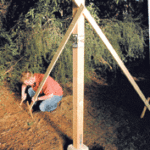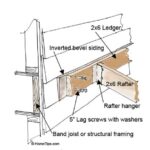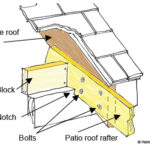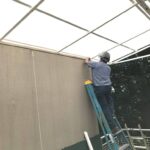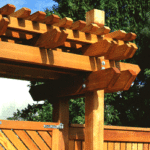A range of materials is used for building outdoor shelters, but the overwhelming favorite is wood.
Though several materials are appropriate for building outdoor structures, the overwhelming favorite is wood. The structural members—posts, beams, and rafters—are generally made from dimension lumber; wood roofs may be made from boards, lath and batten, plywood, woven wood, or shingles.
Popular non-wood structural materials include concrete, stucco, and steel. Popular non-wood roofing materials include outdoor fabric, plastic, glass, and asphalt shingles.
Alternative Woods for Patio Roofs
Traditional lumber products aren’t your only option when designing and planning an outdoor overhead. The following alternatives are chosen for their rustic appeal, ease of construction, low price, or airiness. Some are easy to come by; others may have to be special-ordered.


Preassembled Lattice Panels
Manufactured in 4-by-8-foot, 2-by-8-foot, and occasionally 4-by-6-foot sizes, preassembled lattice panels achieve the appearance of crisscrossed lath without all the measuring, cutting, and fastening. Look for redwood (pictured at right) or cedar, the only woods that will stand up to the elements. Also check the grade before purchasing; the higher the better. Typical patterns are diagonal and checkerboard, though other designs are available.
If you’re looking for a maintenance-free option, consider vinyl lattice panels, which mimic the look of painted wood lattice. They are smooth, durable, resistant to insects and moisture, and never require refinishing. For these reasons, they cost more than wood but may be worth it for the ease of care. Vinyl lattice panels come in 4-by-8-foot or 2-foot-10-inch-by-8-foot sizes in white as well as several earth tones.
Grape Stakes
Long a staple of fence builders for their hand-hewn look, grape stakes are readily available at home and garden centers. They are roughly 2 by 2 inches in thickness and 6 feet long, though split stakes also work well. Redwood and cedar are the choices for outdoor use.
Poles
Usually purchased at a supply company that specializes in unique landscape products, lengths of 1-by-1-inch redwood or cedar, lodge poles that have been pre-treated with preservatives, vegas (lodge poles most commonly used in Southwestern architecture), tree stakes, and bean poles are the materials of choice for a rustic appearance.
Woven Reed
Easily found at most garden centers, woven reed comes in 6-foot-wide rolls that are either 15 or 25 feet in length. The reed is interwoven with stainless-steel wire to enhance endurance, though the wire can be easily cut and re-twisted. However, the wire strands will fail if subjected to constant flexing, so the material should be firmly affixed with nails or staples to a structure that is rigid. Woven reed does not have the same resistance to moisture as do cedar and redwood, so it will need to be replaced every two to three years. Still, because of its low cost, woven reed is an affordable option.
Woven Bamboo
Similar to woven reed, woven bamboo is interwoven with wire and comes in two grades: split and matchstick. The split variety is the coarser of the two, making it preferable for most installations. Matchstick, which is made from thin strips that come from the bamboo stalk’s inner layer, is preferable if you want an overhead that is adjustable. Because woven bamboo is manufactured primarily for shades, it only comes in 6-foot-long rolls that are 3 to 12 feet wide.
Woven Spruce & Basswood
Like other woven materials, these woods are interwoven with another element, in this case string. For outdoor use, choose a material that is interwoven with a high grade of seine twine.
Manufactured Metal Patio Roofs
Manufactured metal systems are a popular option for homeowners who want a low-maintenance, easy-to-assemble patio roof or trellis.
These tend not to be for do-it-yourself installation. Most available products must be assembled by factory-accredited fabricators.
These patio roofs are manufactured from both aluminum and steel. As a result, they are very durable and easy to maintain.
For residential products, aluminum is the material of choice. It is lighter in weight and easier to work with than steel.
Steel is heavier duty. It is used for commercial structures, like those in parks. But it is also occasionally installed residentially.
Both steel and aluminum are given a durable powder-coated finish—often wood toned—with a long-term warranty. The look of wood is convincing from a distance but, when you’re up close, it becomes clear that it is metal with a stamped texture.
Get a Pre-Screened Local Gazebo or Patio Roof Construction Pro



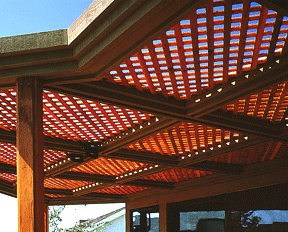
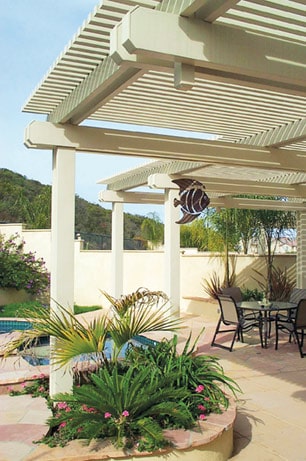
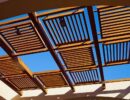
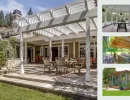

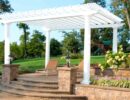
 Don Vandervort writes or edits every article at HomeTips. Don has:
Don Vandervort writes or edits every article at HomeTips. Don has:
